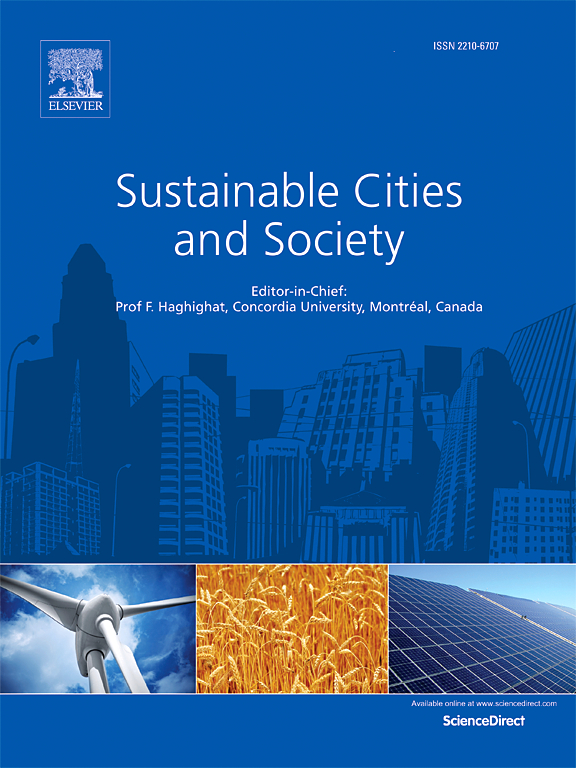Unraveling the effects of extreme heat conditions on urban heat environment: Insights from local climate zones and integrated temperature data
IF 10.5
1区 工程技术
Q1 CONSTRUCTION & BUILDING TECHNOLOGY
引用次数: 0
Abstract
Rapid urbanization and increasing human activities pose significant challenges to urban climates, particularly the urban heat island (UHI) effect, with UHI intensity (UHII) exacerbated by more frequent extreme heat events. Local climate zone (LCZ) provides insights into urban thermal environments but lacks high-accuracy LCZ maps and studies on the extreme heat impacts in non-metropolitan cities. Additionally, gaps exist in understanding how extreme daytime and nighttime heat conditions affect urban heat when integrating seamless near-surface air temperature (NSAT) and land surface temperature (LST) data. To address these gaps, we propose a high-accuracy LCZ mapping framework for the Guanzhong Plain urban agglomeration (GPUA) in China. By combining the LCZ map with 1-km gridded NSAT and LST data derived from machine learning methods, we comprehensively analyze extreme heat effects on surface UHII (SUHII) and canopy UHII (CUHII) at the LCZ scale, considering daytime and nighttime conditions. We also discuss the impacts of changes in radiation fluxes and wind speed associated with extreme heat on UHII. Our findings reveal that: (a) The proposed framework provides an LCZ map over GPUA with an accuracy of 0.84. The maximum RMSE of daytime and nighttime NSAT are 1.73 °C and 1.93 °C, while the maximum RMSE of daytime and nighttime LST are 1.95 °C and 4.20 °C. (b) Extreme heat amplifies NSAT and LST disparities among LCZs, intensifying CUHII and SUHII more during the daytime than at nighttime, although nighttime extreme heat can lower CUHII and SUHII in certain built LCZs. (c) Higher daytime UHII under extreme heat correlates with increased differences in downward longwave radiation between built LCZs and LCZ D. These insights aid in mitigating urban heat risks and guide policymakers and urban planners.
求助全文
约1分钟内获得全文
求助全文
来源期刊

Sustainable Cities and Society
Social Sciences-Geography, Planning and Development
CiteScore
22.00
自引率
13.70%
发文量
810
审稿时长
27 days
期刊介绍:
Sustainable Cities and Society (SCS) is an international journal that focuses on fundamental and applied research to promote environmentally sustainable and socially resilient cities. The journal welcomes cross-cutting, multi-disciplinary research in various areas, including:
1. Smart cities and resilient environments;
2. Alternative/clean energy sources, energy distribution, distributed energy generation, and energy demand reduction/management;
3. Monitoring and improving air quality in built environment and cities (e.g., healthy built environment and air quality management);
4. Energy efficient, low/zero carbon, and green buildings/communities;
5. Climate change mitigation and adaptation in urban environments;
6. Green infrastructure and BMPs;
7. Environmental Footprint accounting and management;
8. Urban agriculture and forestry;
9. ICT, smart grid and intelligent infrastructure;
10. Urban design/planning, regulations, legislation, certification, economics, and policy;
11. Social aspects, impacts and resiliency of cities;
12. Behavior monitoring, analysis and change within urban communities;
13. Health monitoring and improvement;
14. Nexus issues related to sustainable cities and societies;
15. Smart city governance;
16. Decision Support Systems for trade-off and uncertainty analysis for improved management of cities and society;
17. Big data, machine learning, and artificial intelligence applications and case studies;
18. Critical infrastructure protection, including security, privacy, forensics, and reliability issues of cyber-physical systems.
19. Water footprint reduction and urban water distribution, harvesting, treatment, reuse and management;
20. Waste reduction and recycling;
21. Wastewater collection, treatment and recycling;
22. Smart, clean and healthy transportation systems and infrastructure;
 求助内容:
求助内容: 应助结果提醒方式:
应助结果提醒方式:


